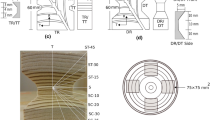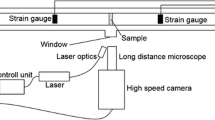Abstract
Failure mechanisms of small clear specimens (6×6×24 mm) of air-dried black spruce (Picea mariana) under parallel-to-grain compression were investigated by polarised-light microscopy. Fatigue load was used with a peak stress level of 90% static strength, a load frequency of 0.5 Hz, and a square waveform with a duty ratio of 0.50. Matched ‘pure’ creep and static load tests were carried out. Damage was quantified in terms of the permanent microstructural changes (kinks) in tracheid walls. In static load tests, kinks develop quickly with any increase in stress beyond the limit of proportionality. In creep tests, damage develops mainly from kinks formed during the initial load application. In fatigue tests, damage develops both from kinks formed during the initial load cycle, and kinks formed during subsequent cycles. The number of kinks exhibits a strong relationship with relative cyclic creep or relative creep.












Similar content being viewed by others
References
ASTM (1997) Standard methods of testing small clear specimens of timber. ASTM D143–87. American Society for Testing and Materials, West Conshohocken, PA, USA
Bach L (1975) Frequency-dependent fracture in wood under pulsating loading. In: forest products research society—annual meeting, Portland, OR. Forest Products Research Society, Madison, WI, USA
Bodig J, Jayne BA (1982) Mechanics of wood and wood composites. Van Nostrand Reinhold, New York, USA
Bonfield PW, Hacker CL, Ansell MP, Dinwoodie JM (1994) Fatigue and creep of chipboard: Part 1. Fatigue at R=0.01. Wood Sci Technol 20:423–435
Bordonne P, Okuyama T, Marsoem SN (1987) Mechanical responses of wood to repeated loading III. J Jap Wood Res Soc 33(8):623–629
Clorius CO, Uhre Pedersen M, Hoffmeyer P, Damkilde L (1996) Fatigue damage in wood. In: Proceedings of international COST508 wood mechanics conference. University of Stuttgart, Stuttgart, Germany, pp 229–242
Côté WA, Hanna RB (1982) Ultrastructural characteristics of wood fracture surfaces. Wood Fibre Sci 15(2):135–163
Dinwoodie JM (1966) Induction of cell wall dislocation (slip planes) during the preparation of microscope sections of wood. Nature 212:525–527
Dinwoodie JM (1968) Failure in timber. Part I. Microscopic changes in cell-well structure associated with compression failure. J Inst Wood Sci 4(3):37–53
Dinwoodie JM (1989) Wood: nature’s cellular, polymeric fibre-composite. The Institute of Metals, London, UK
Gong M (2000) Failure of spruce under compressive low-cycle fatigue loading parallel to grain. PhD thesis, University of New Brunswick, Fredericton, Canada
Gong M, Smith I (1999a) Short-term mechanical behaviour of softwood in high-stress-level compression parallel to grain. In: The fourth international conference on the development of wood science, wood technology and forestry, Forest Products Research Centre, Buckinghamshire Chilterns University College, High Wycombe, England, pp 25–34
Gong M, Smith I (1999b) Low-cycle fatigue behaviour of softwood in compression parallel to grain. In: Proceedings of pacific timber engineering conference. Forest Research Institute Limited, Rotorua, New Zealand, vol 3, pp 437–442
Gong M, Smith I (2000) Failure of softwood under static compression parallel to grain. J Inst Wood Sci 15(4):204–210
Hoffmeyer P (1990) Failure of wood as influenced by moisture and load duration. PhD thesis, State University of New York, Syracuse, New York, USA
Hoffmeyer P (1993) Non-linear creep caused by slip plane formation. Wood Sci Technol 27:321–335
Keith CT, Côté WA (1968) Microscopic characterisation of slip lines and compression failures in wood cell walls. For Prod J 18(3):67–74
Kellogg RM (1958) Strain behaviour of wood subjected to repetitive stressing in tension parallel to the grain. For Prod J 8(10):301–307
Kellogg RM (1960) Effect of repeated loading on tensile properties of wood. For Prod J 10(11):586–594
Kollmann FFP (1963) Phenomena of fracture in wood. Holzforschung 17(3):65–71
Qin DC, Guan N, Jiang XM (1999) Morphology of wood failure in relation to the variation in tensile strength parallel to grain of three hard pines. J Inst Wood Sci 15(1):1–5
Robinson W (1920) The microscopic features of mechanical strains in timber and the bearing of these on the structure of the cell wall in plants. Philos Trans R Soc London B 210:48–82
Scurfield G, Silva SR, Wold MB (1972) Failure of wood under load applied parallel to grain: a study using scanning electron microscopy. Micron 3:160–184
Tsai KT, Ansell MP (1990) The fatigue properties of wood in flexure. J Mater Sci 25:865–878
Acknowledgements
This paper relates to work under the research grant “Control of failure mechanisms for structural timber members and connections” held by the second author and funded by the Natural Sciences and Engineering Research Council of Canada.
Author information
Authors and Affiliations
Corresponding author
Rights and permissions
About this article
Cite this article
Gong, M., Smith, I. Effect of load type on failure mechanisms of spruce in compression parallel to grain. Wood Sci Technol 37, 435–445 (2004). https://doi.org/10.1007/s00226-003-0203-7
Received:
Published:
Issue Date:
DOI: https://doi.org/10.1007/s00226-003-0203-7




